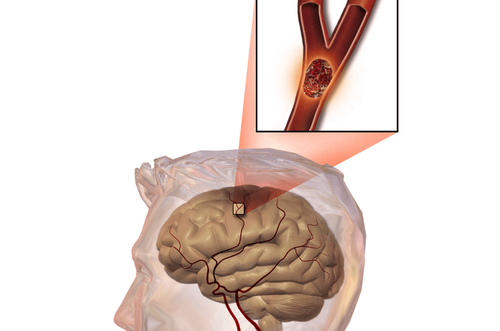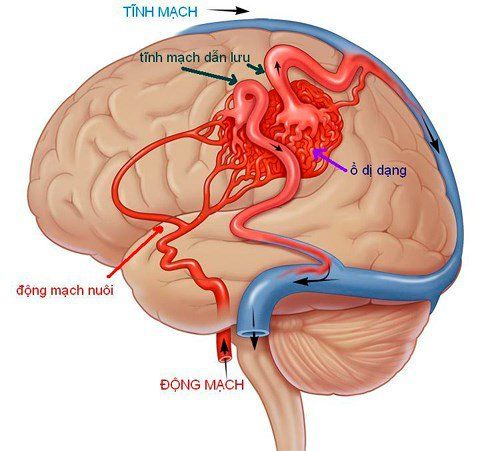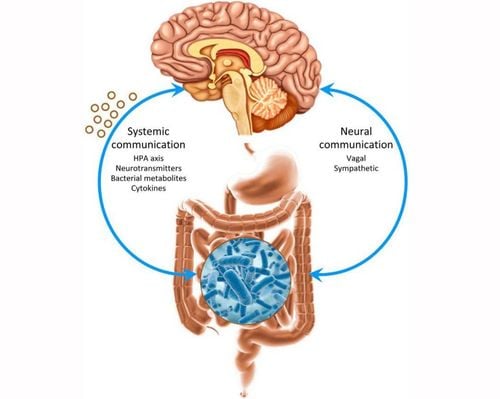This is an automatically translated article.
The article is expertly consulted by Dr. Ton That Tri Dung - Head of Department of Medical Examination & Internal Medicine, Vinmec Danang International Hospital.Cerebral vascular malformation causes many health problems, the most common being broken blood vessels leading to stroke due to cerebral hemorrhage or junctional pressure on the brain leading to seizures and convulsions.
1. What is cerebrovascular malformation?
Cerebrovascular malformation is an abnormal connection between arteries and veins in the body. Cerebral blood vessels in the area of the brain are often divided into many small branches and when they reach a certain point, the blood vessels will branch into many small vessels called capillaries. Capillaries are about the diameter of a blood cell, about one-fifth the size of a human hair. Normally humans have a lot of capillaries, the flow and pressure inside the capillaries are very low.
Due to the abnormal connection between the artery and the vein, the blood flows through the malformed blood vessel with high pressure and fast. Cerebral vascular malformation causes many problems, the most common of which is a rupture of a blood vessel leading to a stroke due to cerebral hemorrhage or pressure on the brain that causes convulsions and seizures.
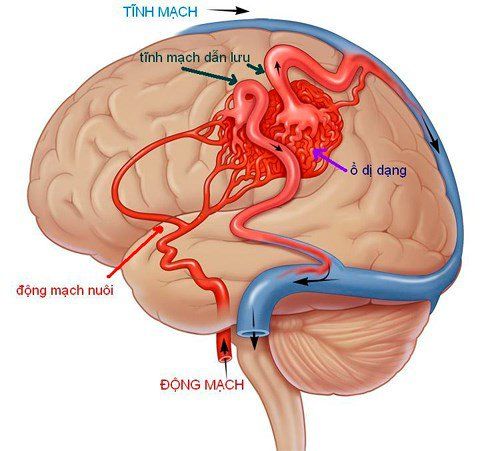
2. Causes of cerebrovascular malformation
Cerebrovascular malformation is a congenital disease, which develops from the fourth to the eighth week of pregnancy, causing the artery to connect directly to the vein without an intermediate capillary network, so most anomalies Cerebral vascular disease can persist in the brain for a long time with few symptoms.
Cerebrovascular malformations are usually detected mainly between the ages of 10 - 40.
3. Typical symptoms warning cerebrovascular malformation
A cerebrovascular malformation may not cause any signs or symptoms until it ruptures, leading to a brain hemorrhage. About half of people with cerebrovascular malformations have the first sign of bleeding.
However, some people may experience signs and symptoms of cerebrovascular malformations other than hemorrhage such as:
Seizures. Headache or pain in one area of the head Weakness or numbness in one part of the body. Others may experience more serious neurological signs and symptoms, depending on the location of the cerebrovascular malformation, including:
Severe headache. Weakness or paralysis. Loss of vision. Hard to say. Confusion or inability to understand others. Severe loss of balance. Sensory disturbances. Scalp varicose veins, however, by middle age, cerebrovascular malformations tend to remain stable and cause few symptoms.
Some pregnant women may experience worsening of symptoms due to changes in blood volume and blood pressure.

4. Medical techniques used to diagnose cerebrovascular malformations
Cerebral angiogram (cerebral angiogram): A small tube is inserted into an artery in the groin. This thin tube is threaded up the blood vessels from the groin toward the brain. Dye is injected into the cerebral blood vessels and the image of the cerebrovascular malformation appears as a vascular plexus. Doctors can see the exact location and size of this deformity. This is considered the most accurate test. Magnetic resonance imaging (MRI) of the brain: This is a method of creating highly detailed images of the body without the need for X-rays. MR angiography uses specially designed “pulse sequences” to show the arteries and veins of the brain as well as cerebrovascular malformations. Computed tomography (CTA) scan: Uses X-rays to take pictures of different parts of the body. A CT scan is a good way to detect bleeding in the brain or areas of fluid around the brain. This brain scan may or may not be done with dye. A CT scan can show a cerebrovascular malformation, especially after X-ray dye is introduced.
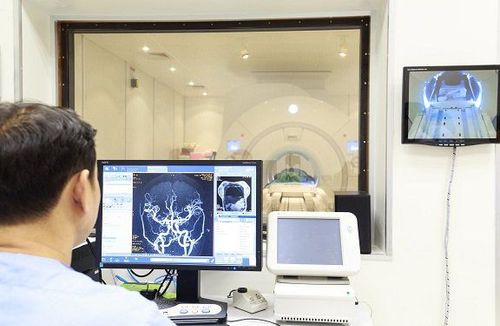
5. Methods of treatment
Your doctor will recommend the best treatment for you and this will be determined by the size of the deformity and its location. There are 3 treatment methods:
Endovascular embolization In this technique, the doctor inserts a long, thin tube into the artery of the leg and threaded it through the blood vessel to the brain under imaging guidance. X-ray. A catheter is placed in one of the arteries feeding to the malformed blood vessel and an embolizing agent, such as small particles, glue-like substances, microcoils, or other materials, is injected to block the artery and reduce flow. malformed blood vessels. Endovascular embolization is less invasive than traditional surgery. It can be done alone, but is often used before other surgical treatments to make the procedure safer by reducing the size of the malformed blood vessel or reducing the chance of bleeding.
Larger malformations and complex structures are often treated with a combination of methods. In these cases, doctors usually embolize the vessels first to reduce the size of the deformity, then open surgery or radiation surgery.
Depending on the overall condition and damage of each patient, the method and treatment plan will be selected in the most appropriate way.
Radiation treatment This is also known as radiation surgery or radiosurgery. A narrow X-ray beam focuses on the malformation so that the high dose targets the cerebral arteriovenous malformation and the rest of the brain suffers a much lower dose. This radiation causes cerebral vascular malformations to contract and close over a period of 2-3 years in 80% of patients. The risk of complications from this procedure is low. Until the cerebrovascular malformation is completely closed, the risk of bleeding remains.
Surgery This is the oldest method of treating cerebrovascular malformations. The malformation is removed in the operating room under general anesthesia. Open the skull, clamp and cut the malformed blood vessels. Usually applied when the ruptured malformation causes intracranial hematoma or the large malformation causes focal neurological signs. The risks of surgery are often high for cerebrovascular malformations located deep in the brain with vital functions.
Besides, there is another option of doing nothing and just monitoring the disease. Your doctor may recommend follow-up if they feel the treatment is unsafe or find out that you are older.
Doctor - Doctor Ton That Tri Dung - Head of the Department of Examination and Internal Medicine - Vinmec Danang International General Hospital said: "Cerebral arteriovenous malformation is a very dangerous disease, when rupture causes death. very high and common after cerebral aneurysms. Although cerebral arteriovenous malformations are dangerous diseases, their symptoms are often very vague (mainly prolonged headaches or seizures..), so most patients with this disease are easy to miss until they are diagnosed. Cerebral vascular malformation bursts and causes acute symptoms. At that time, patients often come to the hospital with emergency conditions such as vomiting, headache, confusion, paralysis of limbs and can lead to death if not treated in time.”
Neurology - Department of Examination and Internal Medicine - Vinmec Da Nang International General Hospital is the address for treating cerebral vascular malformations with many outstanding advantages such as: There are many different specialties, a team of experienced doctors in specialized fields, modern equipment system..
Head of Department is Doctorate - Doctor Ton That Tri Dung has nearly 30 years of experience in stroke neurology with many awards in research scientific research. Particularly for cerebral vascular intervention, the doctor has performed for 6 years and every year takes pictures and intervenes about 480 - 500 cases.
Dr. Dung was trained in neurology at home and abroad, taught at the Medical University. Hue Pharmaceutical and holds many important positions at Hue Central Hospital.
Please dial HOTLINE for more information or register for an appointment HERE. Download MyVinmec app to make appointments faster and to manage your bookings easily.






